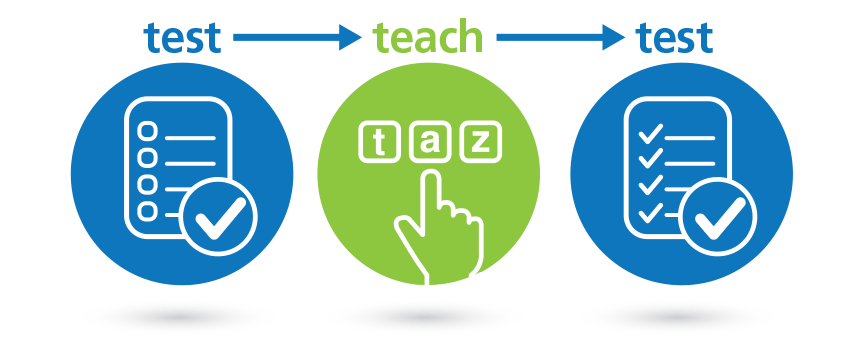The PEARL is a Kindergarten Dyslexia Screener that accurately identifies future decoding and comprehension difficulty in minutes. The PEARL assesses critical skills within the decoding and language domains and is designed to be a universal screener for all incoming kindergarten students.

The PEARL is a dyslexia screener that accurately identify future decoding and comprehension difficulty in minutes!
What is included in the PEARL Screener:
- PEARL Screener Examiner’s Manual
- PEARL Screener Stimulus Book (User Options: 1 Stimulus book/1 User, 3 Stimulus Books/3 Users, 5 Stimulus Books/5 Users)
- PEARL Screener Protocols (25 included) Additional protocols available to purchase
- PEARL Carrying Bag
Highlights of the PEARL Screener
- Only takes 5-15 minutes to administer (in majority of cases)
- Accurately predicts future decoding and comprehension difficulty with 80% (or higher) sensitivity and specificity
- Reduces cultural and linguistic bias with 80% (or higher) sensitivity and specificity
- Informs present level of decoding and academically related language ability
- The PEARL can be administered by anyone who can read and understand the test manual and has knowledge of standardized assessment procedures

An introduction to the PEARL
The Predictive Early Assessment of Reading and Language (PEARL) Screener employs an innovative assessment approach referred to as dynamic assessment. Through dynamic assessment, the PEARL measures the construct of modifiability (the ability to learn something new) in the domains of decoding and literate (academic) language production and comprehension. In a single testing session (often under 10 minutes), examiners assess gains from pretest to posttest as well as the student’s response to quality teaching. The effects of teaching on a student’s decoding and language can be observed and measured, and the results reveal how easy or difficult it will likely be for a student to learn those skills. As a result, an estimation of a student’s need for intervention can be made quickly, without needing to monitor response to teaching over months or years. Dynamic assessment has shown promise for excellent prediction. When early identification is possible, earlier intervention and prevention are also possible.
Combat dyslexia with the predictive power of the PEARL
The International Dyslexia Foundation states that between 15% and 20% of the population have a language-based learning disability, dyslexia being the most common of these. For these students, early screening matched with meaningful, targeted and systematic intervention is key to help a student achieve academic success. Quite often these students don’t get noticed until they show significant signs of struggle, often times at a point where it is difficult to make significant gains. The predictive power of the PEARL is a game changer for these students.
Meaningful early intervention starts with an accurate screener.
- Accurately predicts future decoding and comprehension difficulty in minutes.
Sensitivity and specificity analyses of the PEARL across over 1000 students indicate that the Decoding and Language subtests yield sensitivity and specificity above 80%, and that these results can be obtained after a very brief screening process.
- Reduces cultural and linguistic bias, accurately predicting of the information used to predict future reading and language difficulty for diverse children.
Across culturally and linguistically diverse students (including Hispanic students, Native American students, and students from lower socio-economic backgrounds), the PEARL yielded sensitivity and specificity at or above 80%, indicating limited assessment bias and excellent predictive validity for a diverse group of students.
- Informs present level of performance of decoding and academically related language ability.
Results of the PEARL provide information on a student’s current ability to decode, and understand and use complex language.
- Helps ascertain a student’s zone of proximal development and specific deficits and strengths related to decoding and language.
Results of the PEARL help an interventionist understand how much support a student might need to successfully decode and understand and use complex language, and identify which specific intervention goals would be most appropriate for an individual student.
Do you know which students will struggle with decoding and comprehension?
The PEARL provides measures of decoding and comprehension well before a student learns how to read.

The Predictive Early Assessment of Reading and Language (PEARL) screener employs an innovative assessment approach referred to as dynamic assessment. Through dynamic assessment, the PEARL measures the construct of modifiability (the ability to learn something new) in the domains of decoding and literate (academic) language production and comprehension. The PEARL was carefully designed so that its content reflects skills that students will need to master in school.
What does this mean for you as a teacher? You will know before you even start teaching your students, which will struggle in large group settings to understand decoding and language concepts. Instead of waiting until they fail, you will be able to immediately provide the necessary intervention to help these students make gains in their learning, increasing the chances the every student in your classroom succeeds.
The Predictive Power of Dynamic Assessment

An introduction to dynamic assessment
The Predictive Early Assessment of Reading and Language (PEARL) screener employs an innovative assessment approach referred to as dynamic assessment. Through dynamic assessment, the PEARL measures the construct of modifiability (the ability to learn something new) in the domains of decoding and literate (academic) language production and comprehension.
In a single testing session (often under 10 minutes), examiners assess gains from pretest to posttest as well as the student’s response to quality teaching. The effects of teaching on a student’s decoding and language can be observed and measured, and the results reveal how easy or difficult it will likely be for a student to learn those skills.
As a result, an estimation of a student’s need for intervention can be made quickly, without needing to monitor response to teaching over months or years. Dynamic assessment has shown promise for excellent prediction. When early identification is possible, earlier intervention and prevention are also possible.

What is particularly unique about the PEARL is that through the dynamic assessment process, actual measures of decoding and comprehension of literate language can be measured well before a student learns how to read. The PEARL was carefully designed so that its content reflects skills that students will need to master in school.

Dynamic Assessment of Decoding subtest
The PEARL dynamic assessment of decoding subtest includes nonsense words that rhyme, allowing for both a phonological analysis and analogic decoding strategy. Nonsense words have been shown to be less culturally and linguistically biased and can be appropriate to use with culturally and linguistically diverse students. In a single test-teach-test session, examiners assess gains from pretest to posttest as well as the student’s response to quality teaching. The effects of teaching on a student’s decoding can be observed and measured, and the results reveal how easy or difficult it will likely be for a student to learn those skills. When early identification is possible, earlier intervention and prevention are also possible.
Dynamic Assessment of Language subtest
The Dynamic Assessment of Language features narrative retell tasks that reflect language production and comprehension. Students’ narratives tend to follow a developmental pattern, with complexity increasing as students mature. Narratives across many cultures tend to follow a predictable pattern of organization. Narrative organization is comprised of elements often referred to as story grammar (i.e., story structure). Story grammar can be evaluated based on how clear and complete it is. Story grammar elements are combined to form episodes (plots). The key story grammar elements of a minimally complete episode include a problem, an attempt to solve the problem, and a consequence.







